We’re all spending some time away from our computers so things will be pretty quiet round here till after new year’s. Happy holidays, everyone.
Btw, if:book just turned 3!
Monthly Archives: December 2007
anatomy of a debate
The New York Times continues to do quality interactive work online. Take a look at this recent feature that allows you to delve through video and transcript from the final Democratic presidential candidate debate in Iowa (Dec. 13, ’07). It begins with a lovely navigation tool that allows you to jump through the video topic by topic. Clicking text in the transcript (center column) or a topic from the list (right column) jumps you directly to the corresponding place in the video.
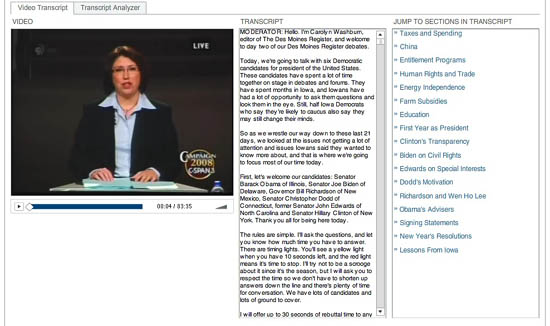
The second part is a “transcript analyzer,” which gives a visual overview of the debate. The text is laid out in miniature in a simple, clean schematic, navigable by speaker. Click a name in the left column and the speaker’s remarks are highlighted on the schematic. Hover over any block of text and that detail of the transcript pops up for you to read. You can also search the debate by keyword and see word counts and speaking times for each candidate.
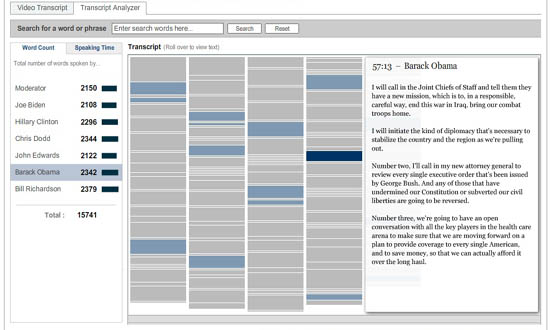
These are fantastic tools -? if only they were more widely available. These would be amazing extensions to CommentPress.
if all the sky was paper
Perhaps the only blog featuring a tag cloud in which ‘Assistant Post Mistress’ looms large, The Travelling Bookbinder in Antarctica somehow seems suitable festive reading for the online book lover.
Book artist and travelling bookbinder, Rachel Hazell, is currently working and living in the world’s most famous post office at Port Lockroy, Antarctica. For six white and blue months, Rachel will be working as Assistant Post Mistress and Penguin Monitor. Entries so far include ‘thinking of poetry and missing it’ and ‘thinking about Ali Smith’s enthusiasm for the spare and simple’. Oh and there are instructions on fashioning a book from a sheet of snow white A4.
a few rough notes on knols
Think you’ve got an authoritative take on a subject? Write up an article, or “knol,” and see how the Web judgeth. If it’s any good, you might even make a buck.

Google’s new encyclopedia will go head to head with Wikipedia in the search rankings, though in format it more resembles other ad-supported, single-author info sources like the About.com or Squidoo. The knol-verse (how the hell do we speak of these things as a whole?) will be a Darwinian writers’ market where the fittest knols rise to the top. Anyone can write one. Google will host it for free. Multiple knols can compete on a single topic. Readers can respond to and evaluate knols through simple community rating tools. Content belongs solely to the author, who can license it in any way he/she chooses (all rights reserved, Creative Commons, etc.). Authors have the option of having contextual ads run to the side, revenues from which are shared with Google. There is no vetting or editorial input from Google whatsoever.
Except… Might not the ads exert their own subtle editorial influence? In this entrepreneurial writers’ fray, will authors craft their knols for AdSense optimization? Will they become, consciously or not, shills for the companies that place the ads (I’m thinking especially of high impact topic areas like health and medicine)? Whatever you may think of Wikipedia, it has a certain integrity in being ad-free. The mission is clear and direct: to build a comprehensive free encyclopedia for the Web. The range of content has no correlation to marketability or revenue potential. It’s simply a big compendium of stuff, the only mention of money being a frank electronic tip jar at the top of each page. The Googlepedia, in contrast, is fundamentally an advertising platform. What will such an encyclopedia look like?
In the official knol announcement, Udi Manber, a VP for engineering at Google, explains the genesis of the project: “The challenge posed to us by Larry, Sergey and Eric was to find a way to help people share their knowledge. This is our main goal.” You can see embedded in this statement all the trademarks of Google’s rhetoric: a certain false humility, the pose of incorruptible geek integrity and above all, a boundless confidence that every problem, no matter how gray and human, has a technological fix. I’m not saying it’s wrong to build a business, nor that Google is lying whenever it talks about anything idealistic, it’s just that time and again Google displays an astonishing lack of self-awareness in the way it frames its services -? a lack that becomes especially obvious whenever the company edges into content creation and hosting. They tend to talk as though they’re building the library of Alexandria or the great Encyclopédie, but really they’re describing an advanced advertising network of Google-exclusive content. We shouldn’t allow these very different things to become as muddled in our heads as they are in theirs. You get a worrisome sense that, like the Bushies, the cheerful software engineers who promote Google’s products on the company’s various blogs truly believe the things they’re saying. That if we can just get the algorithm right, the world can bask in the light of universal knowledge.
The blogosphere has been alive with commentary about the knol situation throughout the weekend. By far the most provocative thing I’ve read so far is by Anil Dash, VP of Six Apart, the company that makes the Movable Type software that runs this blog. Dash calls out this Google self-awareness gap, or as he puts it, its lack of a “theory of mind”:
Theory of mind is that thing that a two-year-old lacks, which makes her think that covering her eyes means you can’t see her. It’s the thing a chimpanzee has, which makes him hide a banana behind his back, only taking bites when the other chimps aren’t looking.
Theory of mind is the awareness that others are aware, and its absence is the weakness that Google doesn’t know it has. This shortcoming exists at a deep cultural level within the organization, and it keeps manifesting itself in the decisions that the company makes about its products and services. The flaw is one that is perpetuated by insularity, and will only be remedied by becoming more open to outside ideas and more aware of how people outside the company think, work and live.
He gives some examples:
Connecting PageRank to economic systems such as AdWords and AdSense corrupted the meaning and value of links by turning them into an economic exchange. Through the turn of the millennium, hyperlinking on the web was a social, aesthetic, and expressive editorial action. When Google introduced its advertising systems at the same time as it began to dominate the economy around search on the web, it transformed a basic form of online communication, without the permission of the web’s users, and without explaining that choice or offering an option to those users.
He compares the knol enterprise with GBS:
Knol shares with Google Book Search the problem of being both indexed by Google and hosted by Google. This presents inherent conflicts in the ranking of content, as well as disincentives for content creators to control the environment in which their content is published. This necessarily disadvantages competing search engines, but more importantly eliminates the ability for content creators to innovate in the area of content presentation or enhancement. Anything that is written in Knol cannot be presented any better than the best thing in Knol. [his emphasis]
And lastly concludes:
An awareness of the fact that Google has never displayed an ability to create the best tools for sharing knowledge would reveal that it is hubris for Google to think they should be a definitive source for hosting that knowledge. If the desire is to increase knowledge sharing, and the methods of compensation that Google controls include traffic/attention and money/advertising, then a more effective system than Knol would be to algorithmically determine the most valuable and well-presented sources of knowledge, identify the identity of authorites using the same journalistic techniques that the Google News team will have to learn, and then reward those sources with increased traffic, attention and/or monetary compensation.
For a long time Google’s goal was to help direct your attention outward. Increasingly we find that they want to hold onto it. Everyone knows that Wikipedia articles place highly in Google search results. Makes sense then that they want to capture some of those clicks and plug them directly into the Google ad network. But already the Web is dominated by a handful of mega sites. I get nervous at the thought that www.google.com could gradually become an internal directory, that Google could become the alpha and omega, not only the start page of the Internet but all the destinations.
It will be interesting to see just how and to what extent knols start creeping up the search results. Presumably, they will be ranked according to the same secret metrics that measure all pages in Google’s index, but given the opacity of their operations, who’s to say that subtle or unconscious rigging won’t occur? Will community ratings factor in search rankings? That would seem to present a huge conflict of interest. Perhaps top-rated knols will be displayed in the sponsored links area at the top of results pages. Or knols could be listed in order of community ranking on a dedicated knol search portal, providing something analogous to the experience of searching within Wikipedia as opposed to finding articles through external search engines. Returning to the theory of mind question, will Google develop enough awareness of how it is perceived and felt by its users to strike the right balance?
One last thing worth considering about the knol -? apart from its being possibly the worst Internet neologism in recent memory -? is its author-centric nature. It’s interesting that in order to compete with Wikipedia Google has consciously not adopted Wikipedia’s model. The basic unit of authorial action in Wikipedia is the edit. Edits by multiple contributors are combined, through a complicated consensus process, into a single amalgamated product. On Google’s encyclopedia the basic unit is the knol. For each knol (god, it’s hard to keep writing that word) there is a one to one correspondence with an individual, identifiable voice. There may be multiple competing knols, and by extension competing voices (you have this on Wikipedia too, but it’s relegated to the discussion pages).
Viewed in this way, Googlepedia is perhaps a more direct rival to Larry Sanger’s Citizendium, which aims to build a more authoritative Wikipedia-type resource under the supervision of vetted experts. Citizendium is a strange, conflicted experiment, a weird cocktail of Internet populism and ivory tower elitism -? and by the look of it, not going anywhere terribly fast. If knols take off, could they be the final nail in the coffin of Sanger’s awkward dream? Bryan Alexander wonders along similar lines.
While not explicitly employing Sanger’s rhetoric of “expert” review, Google seems to be banking on its commitment to attributed solo authorship and its ad-based incentive system to lure good, knowledgeable authors onto the Web, and to build trust among readers through the brand-name credibility of authorial bylines and brandished credentials. Whether this will work remains to be seen. I wonder… whether this system will really produce quality. Whether there are enough checks and balances. Whether the community rating mechanisms will be meaningful and confidence-inspiring. Whether self-appointed experts will seem authoritative in this context or shabby, second-rate and opportunistic. Whether this will have the feeling of an enlightened knowledge project or of sleezy intellectual link farming (or something perfectly useful in between).
The feel of a site -? the values it exudes -? is an important factor though. This is why I like, and in an odd way trust Wikipedia. Trust not always to be correct, but to be transparent and to wear its flaws on its sleeve, and to be working for a higher aim. Google will probably never inspire that kind of trust in me, certainly not while it persists in its dangerous self-delusions.
A lot of unknowns here. Thoughts?
bothered about blogging etc
I’ve never liked seeing movies in groups. After two hours immersed in a fictional world I dread that moment when you emerge blinking into the light and instantly have to give your verdict.
Personally I want time to mull, and for me a pleasure of private reading is not needing to share my opinion – or know what it is – until I’m good and ready.
I have similar problems with blogging. With such brilliant and articulate colleagues knocking out posts for if:book on a regular basis, I must admit I get nervous about adding speedy contributions. And when I do write words I think might be worth sharing, I wonder if I really want to cast them adrift in such fast flowing waters.
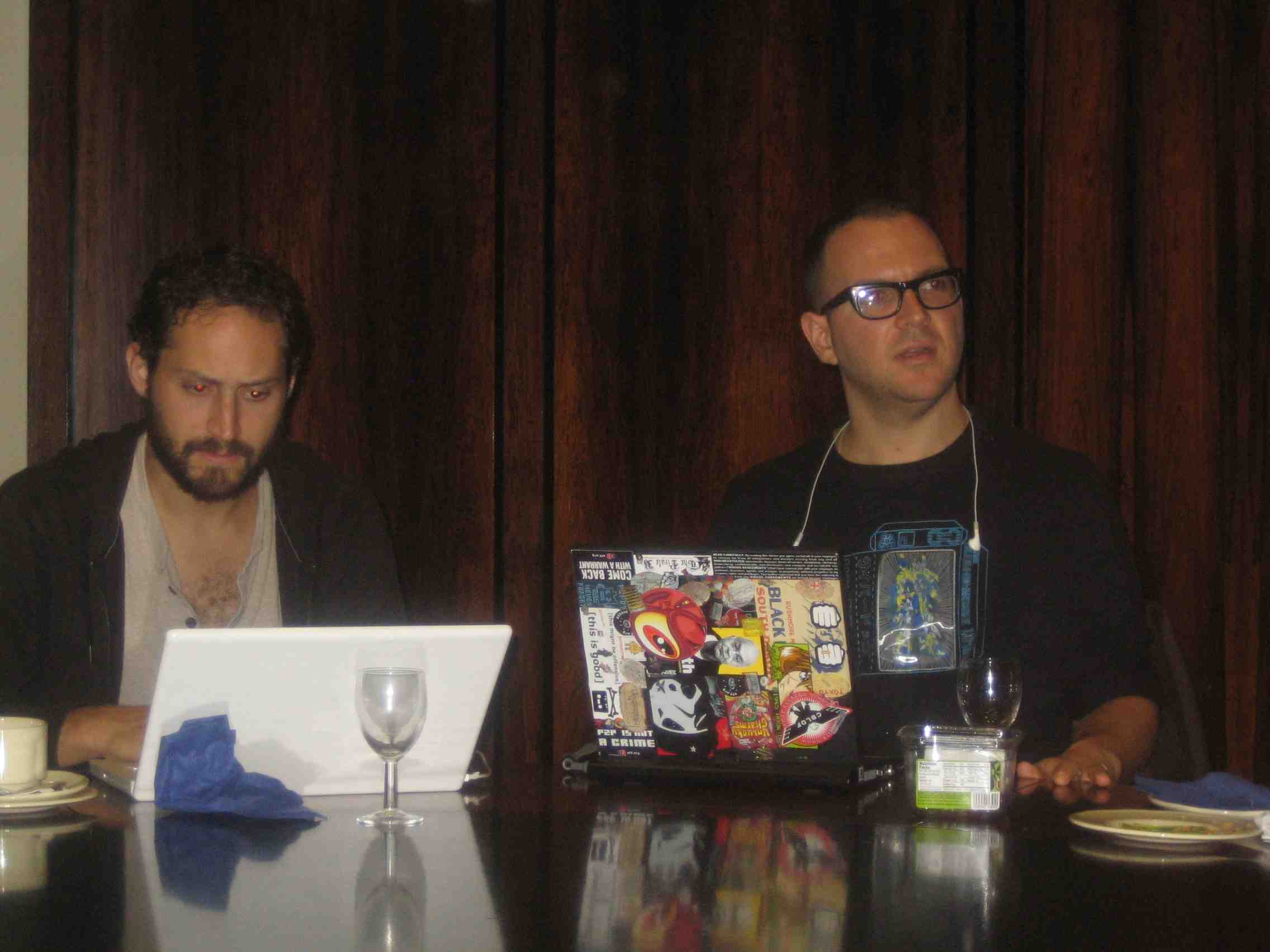
bloggers together – ben vershbow of if:book and cory doctorow of boing boing
I bring this up because the networked book involves active readers happily sharing their thoughts online with others happy to read them.
I dread finding the margins of my e-reader crammed with the scrawlings of cleverclogs, even if I’m free to jump in on their arguments. Having said that, I’m convinced there’s immense potential in building communities of debate around interesting texts. There’s plenty of intelligence and generosity of spirit on the web to counteract the bilge and the bile.
Doris Lessing asks in her Novel prize acceptance speech,
“How will our lives, our way of thinking, be changed by the internet, which has seduced a whole generation with its inanities so that even quite reasonable people will confess that, once they are hooked, it is hard to cut free, and they may find a whole day has passed in blogging etc?”
Lessing’s dismay at addiction to the screen amongst the even quite reasonable is a reminder of the importance of working to heal the cultural divide between bookworms and book geeks. This will involve patience on either side as familiar arguments are replayed to wider audiences. We need to talk in plain English about issues that are so much more interesting and culturally fruitful than many even quite reasonable lovers of literature seem to think they are.
textual montage: the documentary biography
There’s something about the work of Herman Melville that brings out the unexpected in his readers. Example can be drawn almost at random. Call Me Ishmael, the poet Charles Olson’s lyrical little book on Moby-Dick, is as much a meditation on patrimony, artistic and otherwise, as it is about Melville. When the U. S. government locked him up at Ellis Island, the Trinidadian socialist C. L. R. James took the opportunity to move into literary criticism, writing Mariners, Renegades and Castaways: The Story of Herman Melville and the World We Live In, in which he found Melville a sympathetic audience for his argument against state capitalism. Maurice Sendak, best known for Where the Wild Things Are, created semi-pornographic illustrations for an edition of Pierre, Melville’s little-known novel about incest and doubt. Claire Denis turned the comparatively staid Billy Budd into Beau Travail, a sun-dazed film about the French Foreign Legion that culminates in one of the most desparate dance numbers ever. Paul Metcalf, Melville’s great-grandson, smashed together Columbus, teratology, the Bobby Greenlease kidnapping & murder of 1953, and his family’s misgivings about their ancestor to form Genoa, a collage novel.
I set off to write about Metcalf and his unclassifiable books – most of them textual collages made of appropriated writing. Metcalf’s writing is perhaps worth paying attention to in light of electronic media, thoughhere’s precious little about him on the Internet (an interview, an obituary). Thinking about Metcalf’s work, however, I found myself sidetracked: when asked about the inspirations for his textual collages, he pointed to another work on Melville, Jay Leyda’s The Melville Log. I’ll return to Metcalf some other time; he’s not going anywhere.
The Melville Log, though. This is a book that might be just as weird as anything else that Melville ever inspired. It’s also instructive for thinking about how composition in the age of the ubiquitous archive could work. First, a bit of backstory: though Melville was prominent early in his career, he’d faded entirely from the American consciousness by 1920, when Billy Budd was discovered and Moby-Dick was discovered to be the Great American Novel of the nineteenth century. Literary scholars went to work scrutinizing Melville’s life and work; Jay Leyda arrived on the scene in the 1940s, having missed the main boom, but being a big part of a post-war boomlet. In 1951, after years of work, he published The Melville Log, a compilation of first-hand sources about Melville’s life and work. In the half-century since, it’s become a foundational text for anyone seeking to learn about Melville’s life.
I knew that much – just about anyone who’s read Melville has heard of The Melville Log – but I’d never bothered to actually look at a copy of Leyda’s book. From that description, it doesn’t sound interesting. But I found a cheap used copy on Amazon & ordered it; a week later, it turned up on my door. From the dedication, it became clear that this wasn’t the book I’d assumed it was:
This book was begun as a birthday present
for my teacher, Sergei Eisenstein.
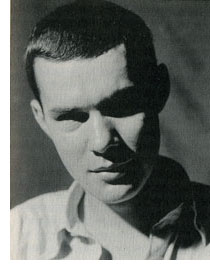 Jay Leyda, it turns out, wasn’t just a literary historian; in fact, he’s best known as a film historian, a field in which he played a foundational role. He had, it seems clear, an interesting life. Considering an career as a filmmaker, Leyda went to Moscow in the 1930s to study film with Eisenstein, the only American to do so; he seems to have worked on Bezhin Meadow as a stills photographer. Returning to the U.S., he served as an advisor to Mission to Moscow, a propaganda film designed to shore up American support for the Soviet Union during WWII (a film later to be soundly denounced as evidence of Hollywood’s un-Americanism). From there he went on to write his Melville book; he also wrote biographies of Emily Dickinson, Sergei Rachmaninoff, and Modest Mussorgsky, as well as a substantial amount of film criticism on Soviet and Chinese films.
Jay Leyda, it turns out, wasn’t just a literary historian; in fact, he’s best known as a film historian, a field in which he played a foundational role. He had, it seems clear, an interesting life. Considering an career as a filmmaker, Leyda went to Moscow in the 1930s to study film with Eisenstein, the only American to do so; he seems to have worked on Bezhin Meadow as a stills photographer. Returning to the U.S., he served as an advisor to Mission to Moscow, a propaganda film designed to shore up American support for the Soviet Union during WWII (a film later to be soundly denounced as evidence of Hollywood’s un-Americanism). From there he went on to write his Melville book; he also wrote biographies of Emily Dickinson, Sergei Rachmaninoff, and Modest Mussorgsky, as well as a substantial amount of film criticism on Soviet and Chinese films.
What’s the importance of this to his book on Melville? If Leyda learned anything from Eisenstein, it was the value of montage, putting adjacent shots into juxtaposition to create new meaning. Leyda explained what he was doing in his introduction:
The result is a book made of documents, documents of many kinds and from many sources, written by many men and women (and some children); but documents cannot be accepted unconditionally. A ‘document’ should be distrusted as much as a photograph, for documents are a fallible as their human authors. Letters contained as many falsehoods and misunderstandings in 1851 as they do in 1951, and journalists and critics (and typesetters) of a century ago operated under much the same pressures that they do today. Each document quoted here requires some judgment of its author’s motives and character – although perhaps the First Mates who kept the whaling logs may be thought beyond suspicion.
(p. xii.) A few scanned spreads from the book give a feeling for its contents, how it juxtaposes bits and pieces of letters, business documents, journals, and Melville’s work, using time – the march of years from Melville’s birth to his death – as its central axis. Essentially, it’s Eisenstein’s montage, moved from the world of film into that of books, with not a little of what would subsequently be called multimedia. Click to enlarge:
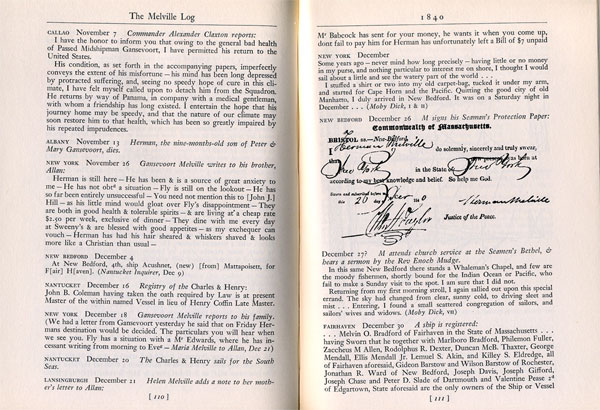
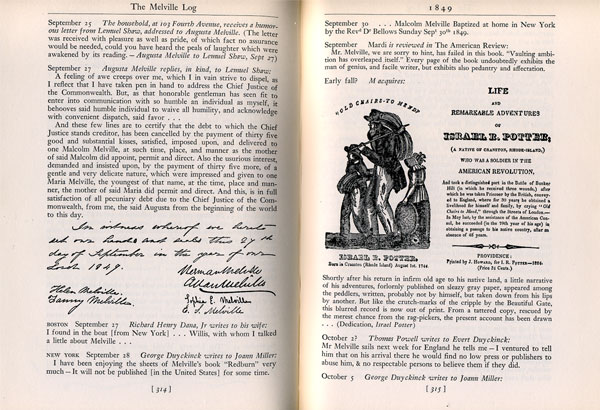
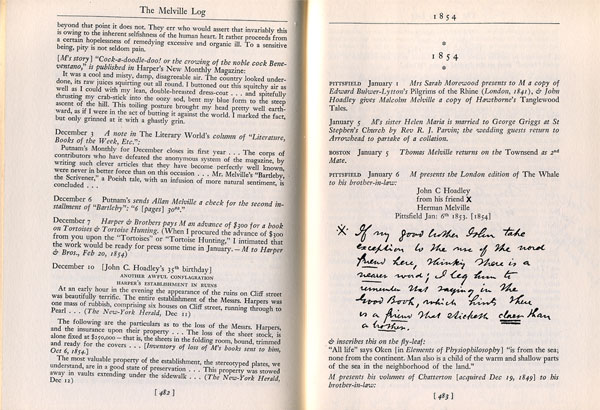
For a book that might be thought of as a biography, there seems to be very little of the biographer: only the unobtrusive introduction to each entry is in Leyda’s hand. (Tucked away at the back of the book, of course, is an enormous list of the sources of quotation.) But lack of the author’s words doesn’t signify the author’s lack of intention. Here’s Eisenstein explaining montage in Film Form, translated by Leyda: “By combining these monstrous incongruities we newly collect the disintegrated event into one whole, but in our aspect.” Leyda, in his own introduction, winks at this: clearly, he’s one of “the First Mates who kept the whaling logs” who would wish to be thought beyond suspicion.
There’s a very interesting reading of Leyda’s collage-work – and the way collage works – in Clare L. Spark‘s Hunting Captain Ahab: Psychological Warfare and the Melville Revival, a thorough dissection of the forces that made Melville into the Melville we think we understand. Melville’s life is a challenge for the prospective biographer: there’s not the usual plot arc or easy moral to be drawn from it, though that hasn’t stopped people from trying to do so: a Great American Novelist needs to behave properly. According to Spark:
Leyda arranged his chronology of Melville’s hitherto confusing or mysterious life to track a progression from Ahab’s family-splitting bourgeois individualism to Billy Budd’s socially responsible sacrifice on behalf of family unity and order, ordering Melville in the process. Every detail of The Melville Log was designed to fortify that message.
(pp. 10–11.) Spark has harsher words for Leyda in her chapter on his work: she sees him as a dyed-in-the-wool Stalinist and details the ways in which suppresses and misrepresents information in the guise of presenting the unvarnished truth. If you’re interested in Melville or twentieth-century American propaganda – from both the right and the left – hers is a fascinating book and well worth seeking out.
* * * * *
But let’s return from the depths of Melville criticism. If, as Spark argues, The Melville Log presents a subjective view of Melville to his readers, it’s only able to do so because Leyda knew that only a miniscule fraction of those who read his book would be able or have the inclination to consult the original documents that he was quoting, the majority of which weren’t publicly accessible.
A thought experiment: what happens if, thanks to book-scanning projects, all those sources were publicly accessible?(The University of Connecticut’s Olson collection might be seen as a start.) Having everything available doesn’t obviate the need for projects like Leyda’s; we need editors to sort through the chaff and to point out the things that are interesting. A born-digital project like this could be instantly accountable in a way that it would be difficult for a print version to be: a link could take the reader from the quotation to the quoted document. Going further: a reader who’s dissatisfied with the slant of a digital Melville Log could assemble their own alternate version.
Technically, this isn’t difficult. But the tools to do this don’t seem to exist yet; and supporting this sort of ecosystem of research doesn’t seem to be an immediate priority for those compiling archives.
a safe haven for fan culture
The Organization for Transformative Works is a new “nonprofit organization established by fans to serve the interests of fans by providing access to and preserving the history of fanworks and fan culture in its myriad forms.”
Interestingly, the OTW defines itself -? and by implication, fan culture in general -? as a “predominately female community.” The board of directors is made up of a distinguished and, diverging from fan culture norms, non-anonymous group of women academics spanning film studies, english, interaction design and law, and chaired by the bestselling fantasy author Naomi Novik (J.K. Rowling is not a member). In comments on his website, Ethan Zuckerman points out that
…it’s important to understand the definition of “fan culture” – media fandom, fanfic and vidding, a culture that’s predominantly female, though not exclusively so. I see this statement in OTW’s values as a reflection on the fact that politically-focused remixing of videos has received a great deal of attention from legal and media activists (Lessig, for instance) in recent years. Some women who’ve been involved with remixing television and movie clips for decades, producing sophisticated works often with incredibly primitive tools, are understandably pissed off that a new generation of political activists are being credited with “inventing the remix”.
In a nod to Virginia Woolf, next summer the OTW will launch “An Archive of One’s Own,” a space dedicated to the preservation and legal protection of fan-made works:
An Archive Of Our Own’s first goal is to create a new open-source software package to allow fans to host their own robust, full-featured archives, which can support even an archive on a very large scale of hundreds of thousands of stories and has the social networking features to make it easier for fans to connect to one another through their work.
Our second goal is to use this software to provide a noncommercial and nonprofit central hosting place for fanfiction and other transformative fanworks, where these can be sheltered by the advocacy of the OTW and take advantage of the OTW’s work in articulating the case for the legality and social value of these works.
OTW will also publish an academic journal and a public wiki devoted to fandom and fan culture history. All looks very promising.
ghost story
02138, a magazine aimed at Harvard alumni, has a great article about the widespread practice among professors of using low-wage student labor to research and even write their books.
…in any number of academic offices at Harvard, the relationship between “author” and researcher(s) is a distinctly gray area. A young economics professor hires seven researchers, none yet in graduate school, several of them pulling 70-hour work-weeks; historians farm out their research to teams of graduate students, who prepare meticulously written memos that are closely assimilated into the finished work; law school professors “write” books that acknowledge dozens of research assistants without specifying their contributions. These days, it is practically the norm for tenured professors to have research and writing squads working on their publications, quietly employed at stages of co-authorship ranging from the non-controversial (photocopying) to more authorial labor, such as significant research on topics central to the final work, to what can only be called ghostwriting.
Ideally, this would constitute a sort of apprentice system -? one generation of scholars teaching the next through joint endeavor. But in reality the collaborative element, though quietly sanctioned by universities (the article goes into this a bit), receives no direct blessing or stated pedagogical justification. A ghost ensemble works quietly behind the scenes to keep up the appearance of heroic, individual authorship.
…and cinematic photographs
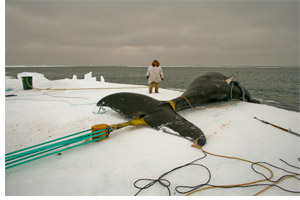 To make a trifecta of film posts for the day, I’ll point out Jonathan Harris’s The Whale Hunt. Properly speaking, this isn’t a film at all; rather, it’s a sequence of 3,214 photographs which Jonathan Harris took over a week’s trip to Alaska to observe a traditional whale hunt. Harris has date-stamped, captioned, and tagged (in three ways) each photograph. They appear in a Flash interface which displays the images in sequence: a very long slideshow. What’s interesting about Harris’s work – and which may merit his declaration that it’s “an experiment in human storytelling” is they way in which tags are used in the interface: if you click the whale that appears in the top center of each photographs, you can change the constraints on the sequence of photographs that you’re looking at. You can choose to see, for example, only photographs taken in Barrow, Alaska; only photographs featuring the first whale killed; only photographs that show children. Or you can choose a mixture of qualifications. One particularly interesting qualifier is the use of “cadence”: you can choose to see pictures that were taken close together in time – presumably when more interesting things were happening – or further apart – when, for example, the narrator is sleeping and has the camera set up to automatically photograph every five minutes.
To make a trifecta of film posts for the day, I’ll point out Jonathan Harris’s The Whale Hunt. Properly speaking, this isn’t a film at all; rather, it’s a sequence of 3,214 photographs which Jonathan Harris took over a week’s trip to Alaska to observe a traditional whale hunt. Harris has date-stamped, captioned, and tagged (in three ways) each photograph. They appear in a Flash interface which displays the images in sequence: a very long slideshow. What’s interesting about Harris’s work – and which may merit his declaration that it’s “an experiment in human storytelling” is they way in which tags are used in the interface: if you click the whale that appears in the top center of each photographs, you can change the constraints on the sequence of photographs that you’re looking at. You can choose to see, for example, only photographs taken in Barrow, Alaska; only photographs featuring the first whale killed; only photographs that show children. Or you can choose a mixture of qualifications. One particularly interesting qualifier is the use of “cadence”: you can choose to see pictures that were taken close together in time – presumably when more interesting things were happening – or further apart – when, for example, the narrator is sleeping and has the camera set up to automatically photograph every five minutes.
My sense in playing with it for a bit is that using constraint in this manner isn’t a tremendously compelling method of storytelling. It is, however, a powerful way of drilling into an archive to see exactly what you want to see.
…and literary cinema

Talking of cinematic readings, I just came across LA artist Sandow Birk‘s visually stunning cinematic update of Dante’s Inferno. The film was made by laboriously creating a paper ‘toy theater’ and then shooting in live film, making for another complex contemporary interplay of paper with digital media.
